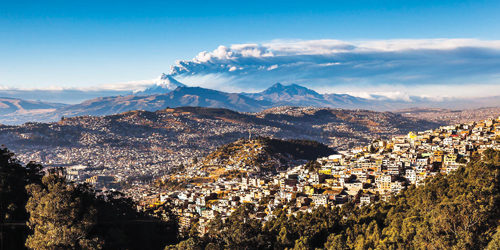
Looking down upon the crater of Pululahua volcano – a couple of irreverent, furry llamas chewing behind me – I’m struck by how green it is. Perhaps naively, I’d expected to see a scorched dent in the earth, a scar on this beautiful patch in the waist of the world. Instead, I’m looking down at lush, cultivated fields and clusters of trees, and the occasional low-rise cottage. Fog is creeping in over the impossibly steep volcano – so vertical to the eye, it seems flat against the sky behind it, like cardboard stage scenery.
Puluahua is the only volcano crater in the world to be inhabited by a community. It’s a small community - currently around 40 people - and one that is completely self-sustained, thanks to the fertile land. “Everything grows here,” says Rosa Chipantasi, who is working to secure a sustainable future for Pululahua. “There are 150 varieties of orchids, all kinds of corn, beans and citrus fruits.”
Climate change has piled the pressure on over the years, meaning farmers have only a few months to sow and grow their produce before weather becomes too wet. The community is also affected by its members leaving the crater and settling 40km away in Quito, seeking the opportunities of city life. Because of this, Chipantasi is launching a series of initiatives to establish Pululahua as a tourist destination. Given its uniqueness, there is great potential for this. Her vision involves creating horseback riding and trekking tours of the crater, along with experiences that will engage visitors with the locals. She’s also set up a summer school for children to visit Pululahua, so they can develop a connection with this rather special place, and potentially consider returning there to contribute to its development when they are older.
All in all, Pululahua’s sustainable approach to development mirrors the capital as a whole. “Quito is a medium-sized city, it’s growing very fast, and it has a lot of challenges for the future,” says Norma Bock, head of Quito Turismo. “It was the first city to be named a UNESCO world heritage site, so there’s a challenge to preserve our heritage and at the same time guarantee that each citizen can benefit from the city.”
In 2016, Quito was chosen as the host city for Habitat III UN Conference on Housing and Sustainable Urban Development. More than 12,000 people from more than 125 United Nations countries travelled to Quito to showcase their latest research and inventions relating to energy savings and clean water systems. And the UN chose Quito for a reason - because it serves as a blueprint for cities at the cusp of making important decisions about how to grow on the international stage, without harming the environment, the culture and the people who live there. “Latin America has the fastest-growing cities in the world,” says Bock. “The region is full of both extreme poverty and wealth. Those kind of extremes create a challenge. In Europe or the US, most cities have long term plans for future development, but this is largely not the case in South America.
“When economies are emerging, development happens faster. The growing middle class in Latin America requires basic services, so the city has to provide them. At the same time, those services have to be sustainable. You have to ask where the energy to power those services is going to come from. Not all developed countries set good examples. In Latin America, we are in a state of transition, and we have the chance to do the right thing, because we have information and can learn from others’ mistakes.”
So, with sustainability in mind, Quito has been heavily investing in infrastructure. In 2013, Quito’s old Mariscal Sucre airport was closed – you may have heard stories about hair-raising landings, thanks to the runway’s steep angle of approach, and the close proximity of people’s homes either side.
Instead, the city opened a new international airport in 2014, 18km east of the city, and the first to be built on new, undeveloped land in Central and South America in the past decade, with one of the longest runways in Latin America. For travellers from London Heathrow, Avianca connects to the Ecuadorian capital via Bogota, while American Airlines connects via Miami, with a journey time of around 17 hours including stopovers.
What’s more, on the site of the old airport, construction began earlier this year on a new convention centre as part of a new development, Bicentennial Park. When it is complete in 2018, it will offer 28,000 sqm of meeting and event space. There has also been US$87 million invested in Quito’s hotel industry over the past few years, and a number of international hotel groups are opening up properties in the city, including Wyndham, Accor Hotels, Hilton and International Hotels Group.
Quito’s strengths as a destination for business travel are its immaculately preserved colonial buildings, which set the scene for unforgettable group dinners and events, as well as its landscape and position at 0 Degrees Latitude. There’s the opportunity for group incentives at Museo Intinan (museointinan.com.ec) – an open air museum where the line of the equator is located, and the magnetic pull of the earth means it’s possible to balance eggs so that they stand upright. And, at Hotel-Restaurant El Crater (elcrater.com), delegates can tuck into Ecuadorian fare while soaking up views of Pululahua crater and the serene green Andes Mountains in its midst.
ECUADORIAN ESCAPES
Whether you want to reward employees, or explore Ecuador for yourself after the hard work is done, here are some unmissable back-to-nature experiences within easy reach of Quito.
BANOS
A three-hour drive from Quito, the lush valley town of Banos is a must for thrill seekers and nature lovers. It’s home to Casa Del Arbo, a swing suspended from a treehouse that sends you soaring into what feels like infinity, with volcanoes and valley views at your feet. Banos is also home to awe-inspiring ziplines over rainforest canyons and rushing rivers, and adrenalin junkies should try their hand at canyoning down the waterfalls of Rio Blanco with MTS Adventure (mtsadventure.com).
HACIENDA EL PORVENIR
Situated two hours from Quito, this high-end yet rustic, pink, thatch-roofed lodge is set at 3,600 metres above sea level, with the snowy peak of Cotopaxi – one of the world’s highest volcanoes – in its midst. Able to accommodate 50 people, its sitting room has a constant roaring fire, while its authentic rooms feature wood fire burners, and hot water bottles are tucked away in the impossibly comfortable beds.
An afternoon horseback trek around the rippling grasslands surrounding Cotopaxi is an unforgettable experience – kitted out in a poncho and chaps coated in llama fur to shield you from the fresh wind. Mountain biking and waterfall hikes are among the activities, and the property recently gained a pine-wood spa, complete with a sauna heated by volcanic rocks. Destination management company Tierra Del Volcan (tierradelvolcan.com) can arrange your stay and activities, as well as an “Innovation Quest” package that involves re-connecting with nature and yourself; it can also be tailored for groups of co-workers to contemplate their personal growth.
WHERE TO MEET
HILTON COLON QUITO HOTEL
With 2,600 sqm of event space – including a ballroom that can hold 800 people – this well-presented downtown property lies opposite Parque El Ejido, where a vast artisan market takes place. It has four restaurants, including a sushi bar, as well as an outdoor pool and a bonsai garden. hilton.com
SHERATON QUITO
Set across from Olimpico Atahualpa stadium in one of Quito’s commercial districts, this practical hotel has two bedroom apartments with kitchenettes, as well as regular hotel rooms. There are two international restaurants, a 24-hour business centre, a club lounge and eight meeting spaces. starwoodhotels.com
HOTEL QUITO
Situated uphill from the centre of Quito – a twenty-minute drive from Independence Square – this unpretentious property has meeting space and comfortable beds (though some rooms could do with an upgrade). The seventh-floor Techo del Mundo restaurant offers 360-degree views of the Andean foothills, and offers live music in the evenings. hotelquito.com
SAN AGUSTIN MONASTERY
It’s possible to host events in this 16th-century monastery in the heart of Quito’s colonial centre, with a peaceful courtyard lined by columned arches, and a patio for dining. Spaces for hire include the refectory where the monks used to dine, and the Chapter Room, where Ecuador’s Declaration of Independence was signed – the latter has lashing of gold leaf and (slightly gruesome) oil paintings depicting the fate of saints.
SAN FRANCISCO CONVENT
The largest colonial building in South America, this beautiful structure has an ornate chapel, a large courtyard and a dining hall with a booth for opera singers to perform from.






